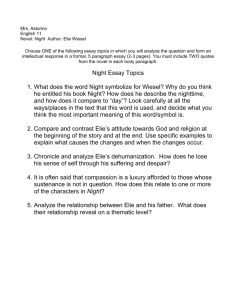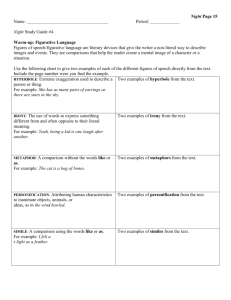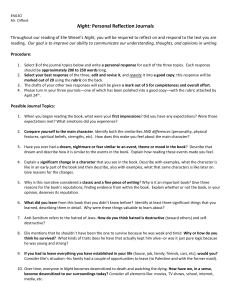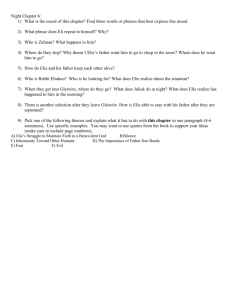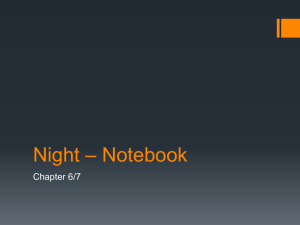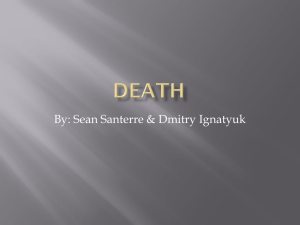File
advertisement
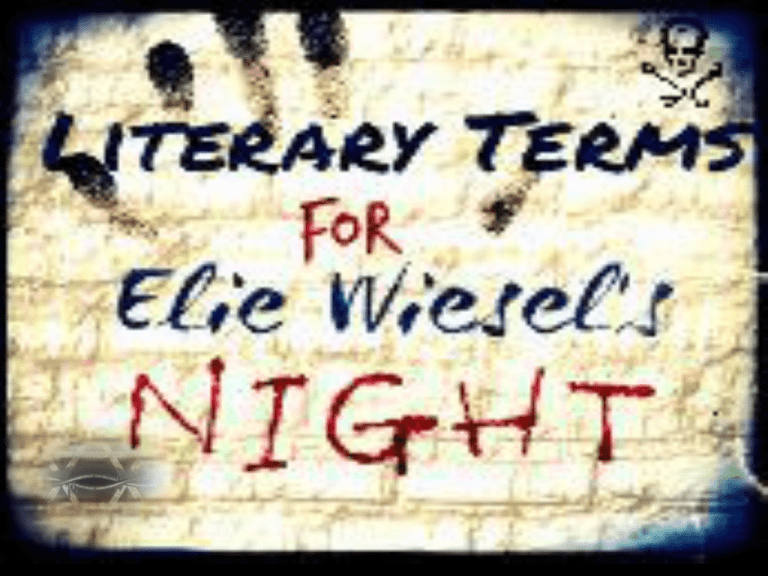
Page numbers given are from the Following Book: 1. 2. 3. 4. 5. 6. 7. 8. 9. 10. 11. 12. 13. Memoir: a true account of one significant experience Symbol: something concrete that represents something abstract Dynamic character: a character who undergoes an important inner change Motif: a recurring idea, theme, or subject External conflict: a character’s struggle with an opposing force Internal conflict: a struggle within the mind of a character Simile: a comparison using like or as Metaphor: a comparison of two dissimilar things which does not use "like" or "as" Irony: referring to how a person, situation, statement, or circumstance is not as it would actually seem. Imagery: words and phrase that evoke the five senses Theme: central idea of a literary work, an insight into life Hyperbole: extreme exaggeration Personification: giving human qualities to animals or objects. On the handout, the definition and one example have been provided for you. You must use your book, Night to locate two other examples for each literary device. Write on your own paper. Return this handout back to me. Rewrite the definition Memoir: a true account of one significant event Give an example The genre of Night is a Memoir. Example-The book Night is about one significant experience in the author’s life— the Holocaust. Symbol: something concrete that represents something abstract 1. “Night” symbolizes the absence of God because to Elie God does not deliver them from the Nazis thus making his life lonely and void of his Best Friend. 2. The hanging of the young Pipel symbolizes the death of God because when the young child suffered unable to die because of his light weight, Elie believed that God must be dead if He would allow such an atrocity to take place. the child to die swiftly. External conflict: a character’ struggle with an opposing force The Jews are held captive by the Nazis. Franek beats Elie’s father to manipulate Elie in exchange for his gold dental crown. Elie struggles to survive despite the cold, meager food, and diseased barracks. Internal conflict: struggle within the mind of a character Elie struggles with doubt about his survival. Elie questions God and struggles with his faith that God is all-loving and allpowerful. Simile: comparison using like or as (Moshe the Beadle) “Physically he was as awkward as a clown” (1). (Madame Schachter) “…she looked like a withered tree in a cornfield” (22). “If anyone is missing, you’ll all be shot, like dogs…” (22). “The barracks we had been made to go into was very long. In the roof were some bluetinged skylights. The antechamber of Hell must look like this” (32). Metaphor: direct comparison “The world was a cattle wagon hermetically sealed” (22). “It was not the first time a false prophet had foretold to us peace-on-earth…And we often believed them. It was an injection of morphine” (76). “Suddenly his eyes would become blank, nothing but two open wounds, two pits of terror” (74). Irony: referring to how a person, situation, statement, or circumstance is not as it would actually seem. “Work is liberty” (38). Sign hanging on wall: “Warning. Danger of Death” (37). “The yellow star? Oh, well, what of it? You don’t die of it” (9). “The SS gave us a fine New Year’s gift” (66). Imagery: Words and phrase that evoke the five senses Description of the leader of the camp (read pg. 45). The hanging of the youth from Warsaw (read pg. 59). Hyperbole: Extreme exaggeration “Yes, man is very strong, greater than God” (64). “We were masters of nature, masters of the world” (83). Personification: giving human qualities to animals or objects. “Death wrapped itself around me until I was stifled” (82). “Around me everything was dancing a dance of death” (84). • Create literary term flashcards. • Front side: Give literary term and one example. • Back side: Give the definition. • Incorporate color and be neat and creative.

